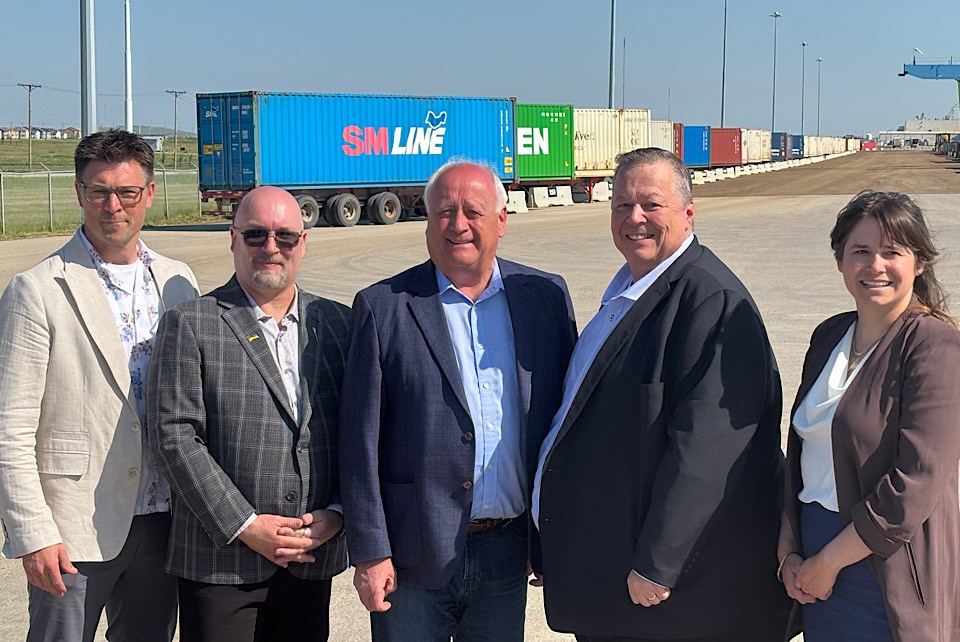REGINA - The provincial government is touting its support of short line rail in Saskatchewan.
At an event at the Intermobil facility outside of Regina Tuesday, Highways Minister David Marit announced the allocation of $1 million in short line rail infrastructure investments to 13 short line rail lines in the province.The $1 million had been previously announced in the provincial budget back in March, representing an increase of $470,000 or 88 per cent from the previous budget.
The $1 million is being distributed through the Ministry of Highways' Short Line Railway Improvement Program, a 50-50 cost share program where the province will be on the hook for one half while the short line rail line will take on the other half. According to the province’s news release, funds go to track upgrades and expansion, improved crossing surfaces and sightlines, bridge maintenance, track rehabilitations and other projects.
Grant amounts are determined based on how much track each short line owns, with a baseline funding of $45,000 being provided for short lines with less than 80 km of track.
Of the 13 short line railways, the largest allocations are going to Great Western Railway (Assiniboia, Shaunavon, Coronach) at $250,073 and Big Sky Rail (Delisle, Eston, Elrose) at $167,541.
While the funding was known well in advance, Marit said now was a good time to announce it.
“I think it was just the opportune time to do it,” said Marit. “The short lines were probably getting ready to order the equipment. In fact, I've seen some where they probably have ordered. And I think it's just now the work is going to get done.
So we just felt it was an opportune time to do it.”
The provincial announcement comes on the heels of a media event held last Thursday by the opposition New Democrats in Richardson, outside Regina, alongside the Stewart Â鶹ÊÓƵern Railway. At that event the NDP called for more support for short line rail.
At that event Glenn Pohl, senior railway consultant, had said while he was grateful for the provincial funding commitment much more was needed.
“Right now, we just went up back to $1 million, which is much appreciated, but that $1 million is split up between 13 railways,” Pohl said. “And if you have a lot of miles on your track, you get a lot more money than the person that has less miles. So it's a good start, but I do believe we could use a little more of an influx to help maintain these lines.”
It was also noted at that NDP event that funding for short lines had already been at the $1 million level back in budget year 2017. But since then, the number of short line rail companies had increased from eight to 13, and their costs had also increased in the meantime due to inflation.
In response to those concerns Marit pointed to the year to year increase.
“Everybody can always say they can always use more, right?” said Marit. “I mean, this was over an 80 percent increase in the funding. What it does allow, and the nice part about it… every short line is getting at least $45,000. Some short lines will utilize that money and some won't, right, whether they don't need it or whatever the case may be. The money will be used up. The others that can utilize it, the money will get utilized that way. So that's why we look at it as a very flexible program.”
The minister said work is done within the ministry with their railway division and the short line association to make sure the dollars are utilized. “So it's important. To see an 88 percent increase is a massive increase,” said Marit.
Andrew Glastetter, president of the Western Canadian Shortline Railway Association and also general manager of the Great Western Railway of Saskatchewan, said the funding increase is much needed.
“As far as infrastructure and maintenance goes for shortline railways, the shortline railways took over railway branch lines that were likely to be abandoned by the Class 1 railways,” said Glastetter.
“So there was significant amount of work needed to do to refurbish the railway ties and the rail and the track bed across the shortline railways. And most of the shortlines have been doing a very robust, good job of staying on top of that. We have an extremely good safety record that would speak to that. And part of that is due to the support we've had from the province going back to the early 2000s, when this type of program initially did start. So, yeah, infrastructure maintenance is critically important to us.”
Glastetter also said a lot of the funding doesn't necessarily go towards just the day-to-day maintenance.
“A lot of us are also working on infrastructure projects. We're looking to build business development and explore trade and export opportunities. So sometimes we're also looking into actually improving the track or bringing it up to faster speeds or being able to handle heavier axle loads so that we can kind of, you know, work one- on-one with the Class 1 railways.”
Glastetter noted that in many small communities they are based in, quite often the shortline railways are the preferred employer in the area.
“We offer, you know, full-time work, typically very good benefit programs, very good hourly rates of pay, certainly for a lot of the jobs in comparison to what's available in the local community… I can say certainly for us down in Great Western Railway, we have people knocking on the door looking to come work for us.”




